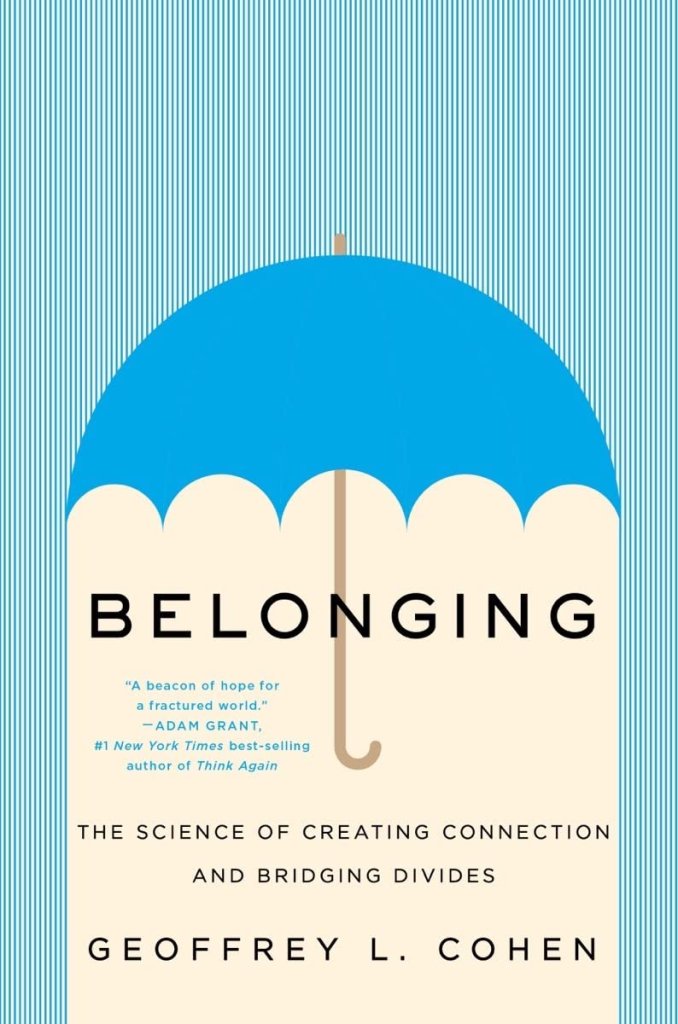The Science of Belonging and Connection
Feeling like you belong in school is critical to academic success—and there are research-backed strategies that educators can deploy, says Stanford psychologist Geoffrey Cohen.
Your content has been saved!
Go to My Saved Content.When social psychologist Geoffrey Cohen took up his first assistant professorship, he couldn’t shake the feeling that he didn’t really fit in. “After I agreed to let a student journalist take a picture of me for an article about teachers in the campus newspaper, I started to think he was planning to pillory me on the front page, envisioning a headline about the worst professor on campus,” Cohen writes in his new book . “I asked him to delete the picture.”
Cohen’s confidence grew with time, as did his feeling of belonging. Today, he’s a at Stanford University’s Graduate School of Education and Department of Psychology and a of human social behavior.
But a memory of that angsty, destructive feeling of alienation stuck with Cohen. Now, his psychology research is oriented around understanding the root causes that drive people—including adolescents—to feel isolated. A lack of belonging is tied to a host of negative outcomes in students, from poor grades to more frequent disciplinary infractions, Cohen writes.
Much of Cohen’s work, meanwhile, is dedicated to identifying simple, easy-to-replicate psychological practices that can bolster a person’s sense of belonging, especially in times of stress or uncertainty.
I sat down with Cohen recently to talk about the rise of loneliness among kids, hourlong interventions that can bring benefits that last for years, and how teachers can create secure social anchors that prevent students from being swept adrift.
Daniel Leonard: So I finished your book Belonging—and loved it. You start by discussing a crisis of belonging in modern society. I’m curious if you see evidence of it playing out among school-aged children as well.
Geoffrey Cohen: �ճ�����’s by Jean Twenge showing that a sense of belonging in school has been on the decline internationally over the past decade. So the data does suggest that students’ sense of connection, at all grade levels, is on the decline. And loneliness is on the rise, too, especially among young adults, who are feeling increasingly disconnected. And then, as you probably know, teen mental health is at red alert—and no one quite knows why. Maybe social media is to blame, the externalization of self-worth that comes from social media.

Leonard: Your new book closely examines the idea of “belonging uncertainty,” which I wasn’t familiar with. What is belonging uncertainty? How common is it, and how does it impact students?
Cohen: The idea comes out of a lot of research that and other people in the field like and have conducted showing that a sense of belonging is really critical for success in school—and at work, and in almost any sphere of human achievement or human interaction.
That sense that we are part of a larger whole, that there is a kind of goodness of fit between me and my environment—that turns out to be really important. For example, one study by Shannon Brady showed that the answer to the single question “I feel like there’s a place for me here at my college”—a numerical agreement on a scale from 1 to 5—predicted retention at four-year colleges better than a slew of other predictors, including high school GPA. So belonging, the sense that this place is a home, can be a real catalyst for health and achievement and growth.
The term belonging uncertainty refers to the feeling that we all encounter in different social environments where we’re not really sure if we belong or not. I personally encounter this all the time. I’m in New York City right now, where I’m kind of an outsider, and I walk into a restaurant or a bar, and feel it. Belonging uncertainty can prompt vigilance. All of a sudden, little things like criticism from a teacher can loom very large and take up a lot of mental bandwidth. If you’re a member of a marginalized group, belonging uncertainty can be a chronic condition.
Leonard: Interesting. And you led a pretty simple “social belonging” intervention study in which first-year college students read reflections from juniors and seniors about how they had also struggled with belonging uncertainty. What did you find?
Cohen: The stories that we shared with the first-year students conveyed two messages. One was: If you’re feeling like you don’t belong here in your first semester or two of college, that’s normal. Everybody feels that way. The second was: It gets better. By putting yourself out there—by knocking on a professor’s door or joining a study group—things improve. And we accompanied those stories with real statistics from a group of seniors that conveyed the same messages.
The intervention is pretty dramatic in its effects. In the , it closed the GPA achievement gap between Black students and White students by 50 percent. , the Black participants reported greater career satisfaction. This was in spite of the fact that it was only roughly an hour in length.
This intervention has since been tested —and it’s pretty powerful there, too. It can reduce stress, boost academic success, and lower absenteeism. And we find effects —that the kids who get this intervention are much less likely to get in trouble in school.
Leonard: You’ve also studied having students do a “values affirmation” activity. Tell me more about that intervention; how does it work, and what makes it so impactful?
Cohen: A self-affirmation is an experience that firms up the self, especially in a threatening situation, and a “values affirmation” is one form of that. The typical values affirmation activity involves giving people a worksheet where they’re asked to circle their most important values: relationships, creativity, sense of humor, and so on. Then, they write about why a particular value is important to them.
A lot of other suggests that value affirmations reduce stress and broaden the self. Because when I’m in a stressful situation, if I can remind myself of the many other things that make me me, it’s like being on a psychological perch. You’re summoning alternative sources of strength and belonging from beyond the situation.
In our study, we found that if you can give these values affirmation activities to students at key moments, it can have these ripple effects. Specifically, when kids got over the course of the first few months of middle school, their GPA improved. And the effects were evident even three years later, after they left middle school.
Leonard: You write that timing really matters. When might these classroom activities be most useful—and how often should they occur?
Cohen: You have to give these activities in a way that communicates an authentic interest in students. So if you give the same activity over and over, or if you give it in a perfunctory way, it’s not going to have the same benefits.
Another key is to give it at timely moments—like during difficult transitions. When kids encounter a setback or hardship during a formative period, that can trigger a downward spiral. For example, if I fail that first test in middle school, that’s going to set the tone. I’m feeling like I don’t belong, and then on the next test, I don’t do as well. And then I just start to disengage.
However, if you can bolster people at that key moment when they’re trying to get a foothold, that can help them get through it. Intervening early, before the consequences accumulate—that gives you a lot of leverage.
Leonard: What about activities that are both prosocial and strongly academic? I was particularly intrigued by research around jigsaw lessons. How do these lessons foster belonging—and what are the academic benefits?
Cohen: The jigsaw classroom comes from that inspired so much of the cooperative learning movement in U.S. education. Aronson created these small groups of five to seven kids working together, and each student got a separate piece of the lesson plan. So if you’re studying something like American history, one kid would get the original settlers, another would get an era like the ’60s and ’80s, and so on. And then each kid, under the guidance of the teacher, becomes an expert in their little piece of the puzzle.
Then the kids get together in small learning groups, which are comprised of one expert in each area. And it’s only by pooling information and sharing it that they can learn the whole lesson in its entirety. Aronson compared it to gift-giving. When I give a gift, I feel a sense of attachment to the person I’m giving it to—and vice versa.
The brilliance of is that there are so many little effects that are conducive to positive outcomes. It’s in the kids’ interests to cooperate. It encourages intimacy. It fosters equal status. If students are having trouble with the material, they can pick up little tips and tricks from their peers. All that combines to create a more congenial environment for kids.
Leonard: You write about the other side of the coin too: that kids sometimes partake in antisocial activities out of an unmet need to belong. How do we direct this powerful desire in the right direction—and steer kids away from more destructive forms of belonging?
Cohen: Someone put it to me like this: A teenager will do anything to belong to a group. A lot of us will—if you don’t have a secure anchor, you can be swept adrift very easily.
I think the solution is for schools to provide students with other channels of belonging. Kids, especially teenagers, want good relationships with adults—but it’s very hard to get those in middle and high schools. A lot of schools can feel like impersonal factories, with kids circulating from one classroom to another. Also, a lot of punitive policies just aggravate the problem by making kids who are misbehaving feel even more like they don’t belong, so they act up even more.
So, I think there are certain things schools can stop doing, like having too many punitive policies. And then there are certain things that they can start doing. For instance, by Joe Mahoney that providing kids with extracurricular activities can be very effective. Overall, it’s about creating a place where people feel like they belong.
Leonard: Can you share some final thoughts for teachers looking to increase their students’ sense of belonging?
Cohen: I know it sounds obvious, but asking good questions—and listening to the answers—that’s the solution to so much. Make it clear that you’re available as a teacher. Say, “If you’re not feeling at home, I want to know.”
Also, we have a tendency in this culture to think that bad behavior comes from bad disposition. That poor performance comes from a lack of ability. This is what my colleague Lee Ross calls the “.” We overestimate the role of the student’s disposition and underestimate the external situations that they’re dealing with. So fight the fundamental attribution error. That’s one of the most important things you can do.
This conversation has been edited for length and clarity.
